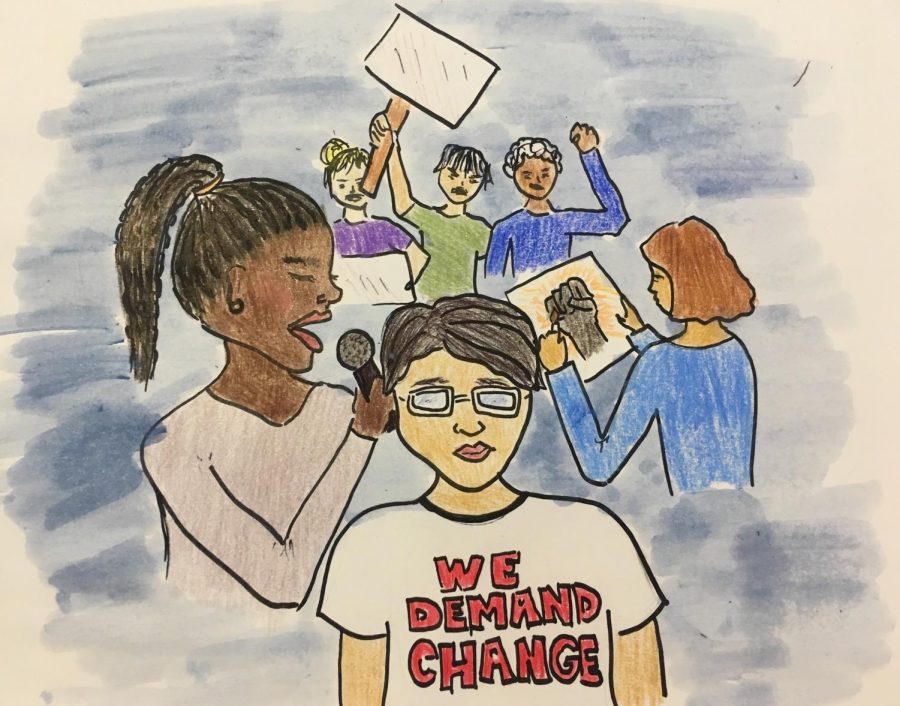Fight for the future: youth activism needs to be encouraged
April 26, 2019
On Sunday, April 14, the North Shore Association of Student Activists (NASA) held a showcase that featured students presenting forms of activism that took on many different areas of art, including physical and verbal. The issues that these students addressed ranged from women’s empowerment to ending the dehumanization of black people. The spoken word, songs, and dances that were performed were all unique, yet similar in that they all addressed forms of injustices that exist in society and the lives of the presenters. Each person who wanted to project their voices and share their concerns was able to do so in a way that they seemed to enjoy. Not only was it an experience that left me reflecting, but being a part of a space where everybody is energized to make change was an amazing opportunity.
Here at ETHS, we have a wide variety of programs that provide such opportunities to discuss and make change around certain issues. However, some people may not have the access, time or courage to do so.
Although this idea of wanting to inspire change is something that youth may be interested in pursuing, it also can be difficult to navigate. Some people may have worries associated with whether or not they have an adequate level of education on a topic they are passionate about, or if they have the right resources to carry out acts of advocacy. The truth is that these worries are normal and should not be impeding one’s ability to speak out on issues they care about.
Nia Williams, senior and presenter at the NASA showcase, says, “As long as you do something that involves expressing yourself, that’s where the liberation begins, if somebody is listening to you, it will make an impact. The person listening can even be yourself.”
Women’s Empowerment Club member Kendal Sohn furthers this thought by saying, “Not everybody who wants to be involved in activism has to be an expert. Coming in and wanting to learn and make an impact is important,” Sohn says.
For certain issues that directly affect particular groups of people, these targeted and oppressed people need to be the forefront of activist movements, as these are the people who directly experience oppression. This includes children and students who unfortunately encounter some form of injustice.
For example,14 year old Marley Dias was fed up with books that featured white boys as the main characters in her school curriculum. She initiated the “1000blackgirlbooks” campaign, which collects and distributes books featuring black girls as the main character. To this day, she has collected over 10,000 books. Since the initiation of her campaign, she has engaged in inspired conversations with Michelle Obama, Oprah Winfrey and Hillary Clinton, who are all very powerful change makers. Not only is she doing work to educate her peers and uplift an underrepresented and overlooked identity, but her campaign has inspired young generations to follow her lead and take advantage of opportunities to make a change.
The fact that Dias, a young woman of color, was able to put her passions to work and start her campaign is extremely impressive and rare. Hopefully, more children and teens encompassing a diverse range of identities will be able to follow in Dias’ footsteps and decrease the abnormality of youth-led movements.
Similarly, 10-year-old Flint resident Mari Copeny, also known as “Little Miss Flint,” generated a page to raise money to donate clean water bottles to other Flint citizens. Copeny has worked tirelessly to serve and help other residents of her hometown, and she is continuing to advocate towards ending the Flint water crisis.
Copeny is a great example of somebody who, at a young age, was able to initiate a movement and work towards solving an issue she is passionate about.
A contributing factor to the discouragement of youth activism is that societal norms perpetuate complicated dynamics between people in power and the oppressed. Education is systematically more accessible to white folks and people with privilege.
The continuation of these norms is what may cause younger people, especially children and teens of color, to think that their views and interpretations concerning certain topics are too weak to act on. This concept of “not being knowledgeable enough” plagues the minds of many youth. It is the people who have this society-fed mindset that need to realize why their desires to make a change are meaningful and should be encouraged.
Another beautiful aspect of youth activism and activism in general is that contrary to common thought, it does not solely involve somebody standing on a soapbox with a projected voice, holding a bold poster. The manifestations of activism truly come in many different ways, shapes, and forms.
Some of the ways in which desires to make an impact have previously manifested are incredible; however, in our current society these effects seem to have been muted by convenience. It should be known that while efforts to share a position against a certain issue are admirable, social media posts are simply not making a change. It is most likely that an issue of focus on somebody’s Instagram story is being addressed by several organizations. Rather than republishing a simple screenshot or hashtag, it is most effective to put in the effort in order to initiate or contribute to some sort of positive change.
When I was younger, I frequently got upset with adults around me when I was unable to voice my concerns because I was afraid nobody would take me seriously. It is extremely relieving and gratifying that times are beginning to change, and in our current society, the anxiety of being looked down upon for speaking up because of one’s youth is starting to disappear.
Youth activism is something that has become more accepted and positively viewed in recent years, and has certainly made an impact. Society’s progression towards enabling younger age groups to find a platform for activism is incredible. However, we need to continue to reinforce and maintain the existing culture of youth advocacy. Kids and teens across the globe should realize the power in their voices, and that these voices are imperative for changing the world for the better.
It is important, however, that we continue to expand access to spaces where everybody is passionate about certain issues. This is what will continue to inspire younger generations to make a change, and help get everybody involved.
Here at ETHS, we have a wide variety of such programs that provide opportunities to discuss and make change around certain issues that should be taken advantage of by all students.
In order for our world to undergo serious reform and growth, it’s time that all youth find a way to express their concerns, listen to the concerns of others, and educate others on topics they are passionate about.
“I think youth have this superpower in which we are able to look at different issues and think of ideas that challenge the very system,” Williams says.
Let’s discover and utilize this superpower to continue and expand the fight towards justice for our future, and the future of generations to come.





















